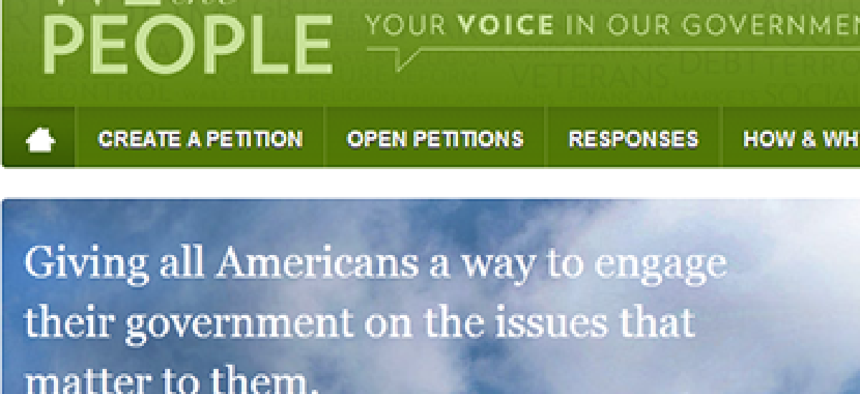White House unveils new open-government goals

The plan is a grab bag of existing transparency initiatives and a preview of policies due out next year.

"We the People" will accept petition signatures collected via third-party sites under the Obama administration's latest open-government plan.
The White House unveiled a new take on its open-government policy that includes consolidating Freedom of Information Act requests across agencies, updating policies governing federal websites and upgrading the way people can petition the executive branch.
The second U.S. Open Government National Action Plan, released Dec. 6, is a grab bag of existing transparency initiatives and a preview of policies due out from the Obama administration in 2014.
The most public-facing development is an update to the White House’s “We the People” site, which allows people to create petitions requesting executive branch attention on particular issues. Petitions that garner 100,000 signatures are eligible, though not guaranteed, to receive some kind of official response. Next year, an application programming interface will allow for the collection of signatures on third-party websites. In addition, the data will be opened to allow for the analysis of petitions and signatures.
Standards for federal websites are also due for a refresh next year, with a plan by the Office of Management and Budget to revise its policies on how government information is presented. In particular, Data.gov will be revised and will include a complete index of agency datasets released under the open-data policy.
For government watchdogs and journalists, an updated FOIA policy will create a one-stop shop for requesting government information. The new portal is not consolidated on the back end, however; requests will still be routed to the 100 agencies covered by FOIA for review. However, the administration has promised to look into the possibility of establishing core regulations for the processing of FOIA requests.
The government is also moving to make spending data more accessible and extensible. The new plan calls for publishing more spending data in machine-readable formats and adding contracting data not currently published on USAspending.gov. The pledges are vague but could take on added specificity with the passage of the Digital Accountability and Transparency Act, which is working its way through Congress.
In the meantime, the White House is moving ahead with plans to release more data at the ForeignAssistance.gov website. Plans for 2014 include adding to the list of agencies required to share information on the site, including the departments of Agriculture, Treasury, and Health and Human Services.
The government is also considering expanding efforts tested by the Consumer Financial Protection Bureau to publish regulations in plain language.
In the wake of disclosures made by former National Security Agency contractor Edward Snowden, the administration promised more transparency on government surveillance. The main goal is to produce public reports on the use of certain national security authorities, including the number of surveillance orders and targets authorized under the Foreign Intelligence Surveillance Act.
The government is periodically releasing declassified national security documents in an ad hoc fashion on a Tumblr blog and is continuing with long-standing plans to tackle the alleged overclassification of documents based on recommendations in a 2012 report. However, officials gave few specifics and no timeline for implementing changes.
National security junkies might be most intrigued by a pilot program being run by the National Archives and Records Administration and the CIA to create new automated tools for government employees with declassification duties. The initial program will analyze the text of email messages from the Reagan administration with the apparent goal of enabling analysis and review of the text and associated metadata to determine whether the material is eligible for declassification. Although the tool has the potential to speed up the declassification process, it is apparently intended for internal use only.






